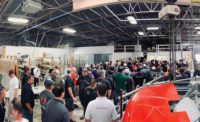During a Stone Industry Education (SIE) event hosted by Triton Stone Group at their facility in Austin, TX, last fall, Blake Christensen of Valley View Granite spoke about use tax verses sales tax. “This is not going to be tax advice, but we have had three sales tax audits and a lot of it depends on the auditor.”
Christensen explained that there are three “buckets.” There is the square footage that is installed as real property, the square footage that goes back into inventory with the potential to convert to a sale later and the square footage that goes in the garbage. “If I bring a 50-square-foot slab in, I need to know exactly what percentage or amount goes into all three of those categories,” he said. “If you can validate and substantiate those three things, there is a huge tax benefit for you and I guarantee you that your audit will go a lot smoother. What we found is that all three times we have been audited, the auditor said to me, ‘You were paying use tax.’”
Use tax is only paid on the square footage of what is installed in real property, Christensen explained. “We can then substantiate the remnants as they go in as a potential or future sale so we don’t have to pay use tax on those,” he said. “Then we take what goes into the garbage, and here’s where we save our money. We put it in a huge pile and crush it and sell it to landscapers – just to save on the tax.
“Let me give you another understanding of the difference,” Christensen went on to say. “You bring in Crema Marfil or a granite for $20 a square foot. Say use tax is 7%. You would have to pay 7% of $20 a square foot of what you throw in the garbage, technically, to be in compliance. But, if you could explain to that auditor you are going to convert this to a retail sale, and I am going to sell it for $3 a ton, now you are paying sales tax on $3 a ton verses $20 a square foot. Does that make sense? It’s hundreds of thousands of dollars a year when you are doing volume.”
Christensen told the audience that it is not cheating the system. “You are establishing a validation of where your material went – into one of those three categories,” he said. “There is a difference in paying use tax on square footage that you installed within your company verses fabrication only. You have to pay tax on the labor because it is a retail sale. Again, I didn’t want to give tax advice. The point was that if you are setting up an inventory system make sure you have those three buckets.”




